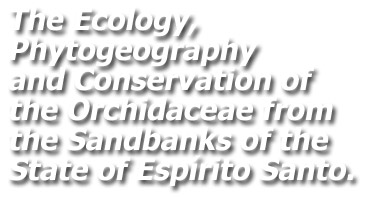

 |
 |
Cláudio Nicoletti de Fraga, botanist, trustee of the alive collections of Botanical Garden of Rio de Janeiro, was born in Vitória, capital of the state of Espírito Santo, the richest Brazilian state in number of Orchidaceae family's species, at least, proportionally to its size. Graduated by the Federal University of Espírito Santo - UFES, he submitted his thesis to become master at the Federal University of Rio de Janeiro. The thesis concerned the orchids from Espírito Santo. "The Ecology, Phytogeography and Conservation of the Orchids from the Sandbanks of the state of Espírito Santo" is a work that brings an important addition to knowledge about the orchids from sandbanks since there is just a few works exclusively about the occurrence of that family in those communities. In this interview, he talks about the influence his father had on the choice of his career, about his work in Santa Teresa (Espírito Santo) and in Botanical Garden of Rio de Janeiro. He also talks about his future projects and mainly about the orchids from the sandbanks of Espírito Santo, about new occurrences and new species he found in that state, all along his researches. |
ON: Could you give us a small profile, where you born, how did you get interested in Botany, in orchids. Cláudio:
I was born in Vitória, in the state of Espírito Santo. Nowadays
I work at the Botanical Garden, although I still have my home in Santa
Teresa no Espírito Santo, where my wife still lives. ON:
We try to keep everything but sometimes we lost many messages when the
computer breaks down as well as with the service of Guest-book. This is
a kind of service that, suddenly, they erase everything and just tell
us that "due to technical matters, all messages are lost". So,
we tell to ourselves: " Oh! Heavens! We had 800 or 1.000 messages,
we didn't save it and service is gone. We lost everything". We feel
great disappointed because the feed back we receive from the people is
very important and encouraging. Now, we are trying to save those messages
out of the computer to avoid those losses. ON: We started in 1996 and the site has been growing a lot since then. Cláudio: It is very big. ON: The site has really a great penetration, we receive e-mails from all around the world, from everywhere in Brazil, from researchers, orchidists, from beginners from orchids societies and associations asking for an authorization to reproduce an article in their newsletter or magazine. Ordinarily, we try to answer all messages but unfortunately we can't keep all of them. When the person is identified as a researcher, we have a special folder for those messages and are useful as a future reference, to keep contact, to clarify some doubt, etc... It is crazy the number of e-mail we receive asking for a link, an information, making remarks about the site. . Cláudio: My site was small and I received a lot of e-mails. Four or five e-mails about the homepage, asking for the craziest information. My wife found it great: - My god! what amazing thing. ON: Which is your site in Internet? Cláudio:
It was a Project called Cores - Conservation of the orchids from the sandbanks of Espírito Santo. I don't have it anymore. ON: What is your formation? Cláudio: I was graduated by the Federal University of Espírito Santo - UFES, but before studying biology, I have been a mechanic, I have done SENAI (Industrial Institution for professional formation) and Federal Technical School. ON: What kind of mechanic? Cláudio:
Heavy and industrial engines, I have been trainee at Vale do Rio Doce, I
worked in a company of hydraulic bombs and another of window frames of aluminum.
I also worked as a draftsman of structural part of building. I did not want
to study, so I decided to have a profession quickly to have money and to
stop studying, or to have a certain independence. Cláudio: I did the preparatory studies to the examinations to get into college and, as all good pupil of school technique, I chose engineering mechanics and, thanks to God, I did not succeed. Today I see it in that way, but by this time I was sad. My father, who is a very present person in my life, spoke that while I did not admit that I was illiterate, I would not pass in any examination. Then, I decided to attend a preparatory course as if I was illiterate. I did the examination for Biology, I got the second place, I entered in the University, I finished the course of graduation in 4 years. I had period of training sponsored for "Aracruz Celulose", later for the "Bahia Sul" and had two grant-aided for scientific initiation when I was already working as botanist. |
|
ON: How did you get into this world of orchids? Cláudio:
I was guided by a botanist from Espirito Santo called Oberdan Jose Pereira.
I wanted to make area of sandbanks and he not only agreed that we studied
any group of plants but also would guide us since we studied areas of
sandbanks because that was the area he was working. Why? Because within
his project of knowing the flora as a whole, he needed people to clarified
doubts in problematic families, thus orchids fit very well into this and
he accepted me.
Cláudio: The project concerned the orchids from the sandbanks of the state of Espírito Santo that had to be done within a year. Of course, I didn't succeed but I traveled the state from south to north, from east to west, going backward and forward. ON: You mentioned the "Fundação O Boticário", but you have also received another sponsorships, didn't you? Cláudio:
After getting my degree in botany, I started to give classes as a substitute
teacher, I submitted my thesis in the end of this period. I got married
and moved to Rio, expecting the grant-aided, which just came six months
later. Things were very difficult and made me to send a project to " O Boticário
Foundation" , to be a candidate for a prize, to get ways that I would never
take, by laziness, if I had the grant-aided. |
|
ON: We would like to talk about your thesis "Ecology, Phytogeography
and Conservation of the orchids from the sandbanks of state of Espírito
Santo". This state is, in fact, concerning the orchids, one of the
richest state of the country, just after Minas Gerais, even though proportionally
to its size, Espírito Santo is richer.
Cláudio: Espírito Santo is still a place to have more orchids than Minas Gerais. I started to collect in 94 and I have six new plants. I have already described one Bulbophyllym gomesii, a new species from the Atlantic Forest, I have a Sobralia, two Bulbophyllum and a Masdevallia to be described and a Myoxanthus which is about to be published. ON: Six plants in seven years...Cláudio: They are very different, this Sobralia, for example, is a plant with |
 |
|
almost three meters height and the flower is the same size of a Cattleya hybrid. How could a plant like this escape to be noticed by someone? ON: I have already seen the photo and asked my self the same thing. Cláudio: In fact, I would like to give you, one day, the photos of those new species, when I will have them effectively published in order to avoid problems. ON: So, it is promised, when they will be published, you give to us to include in Orchid News. Getting back to the new Sobralia, there is an interesting story, you are describing it with Toscano de Britto... Cláudio: He had something very similar. We talked about the Sobralia, but we did not know exactly what everyone was talking about. I said: "- My new species", He said: "- My new species ". We got in touch and and just have elucidated the question when started to discuss about the plant and I showed him the photo. In fact, I think that Toscano has two new species of Sobralia and I have just this one. He proposed a partnership, but there was a problem. He had already started to do the description of some species with Philips Cribb and I think, this Sobralia was one of those new species. Finally, we will do description together, I have collected this plant, sent the herborized material and everything. ON: And about the orchids from Espírito Santo, when can the survey be accomplished? Cláudio: When one studies the part of the mountain regions faced to interior, to the continent. All information available concerns the region turned to the sea. When we say that Domingos Martins is the redoubt of the species, we talk about the part which faces the sea. ON: Everything is turning to the sea? Cláudio: No, but Venda Nova do Imigrante, where lives Luciano Zappi is, Santa Teresa where Ruschi lived also. Santa Tereza is on the top, so Ruschi ... ON: He looked at both sides... Cláudio: Yes, he did but he looked more at the other side. There is, for example, Pseudolaelia dutrae which is a typical plant of rupestrian fields, in altitude, closed related to Pseudolaelia corcovandensis, that also appears in Minas Gerais. Bulbophyllum terezensis, another plant he described from the continental side of the mountain, a plant that also appears in rupestrian fields, in São José (Minas Gerais) and in many other mountains. However, Renata canaanensis (Pseudolaelia canaanensis) is very local but there are some indications that it is also occurring towards the south of the state, in Venda Nova do Imigrante. Pleurothallis rupestris, do you know it? this "fat" Pleurothallis which grows in rupestrian fields, a plant with terete and acicular leaves, with small with red flowers. It is used as a detector of rupestrian fields. There is it in Espírito Santo, in the hillside turned to the continent. There are many examples like this in other families such as melastomataceae, bromeliaceae. In the south part, there is Laelia tenebrosa, but we have no idea how many last in the state. Why because we have no idea that what last in Tableand Forest. so... ON: When you say that you have no idea, you mean: you have really no idea or it is a metaphor? Cláudio:
No, we don't know, we have no idea. ON: What is exactly a Tableland Forest and where is it located? Cláudio:
You have to turn back to the geological ages. The Atlantic Forest in Espírito
Santo, as well as the one in Rio de Janeiro (except for the one in Campos)
is Hillside Atlantic Forest, dated from the Pre-Cambrian age. It is a
very old terrain, the rock turned into earth. From time to time, there
are those boulders in the middle of the forest and you how it appeared.
It didn' appear, it is what was left over. It is quite common in Rio de
Janeiro and also in Espírito Santo until the region of Santa Teresa.
Then it goes through Pancas, Barra de São Francisco. This is a
kind of peculiar terrain to Serra do Mar (Sea Mountains). ON: So this is kilometers of sliding. By the way, why Hylean? |
| Cláudio:
Yes, kilometers far away. Those forests are called Hylean because they have
a strong similarity with the Hylean situated in Amazon River basin at least,
in the appearance. Examining under the point of the view of Floristics, we concluded that many of them are really simultaneous in both systems. For example, if we stay limited to the north of Espírito Santo, the most common genus is Catasetum. If we get all the state, there are many species of Pleurothallis, Epidendrum, but in the north of the state, the presence of Catasetum is something very interesting. There is Catasetum discolor which grows on the sand all along the sandbank, |
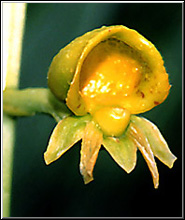 Catasetum discolor (female flowers) |
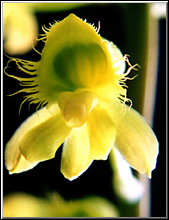 Catasetum discolor (male flowers) |
| but there are Catasetum purum, Catasetum macrocarpum, Catasetum luridum. Those species are there, very different from the south region; it is a different forest. |
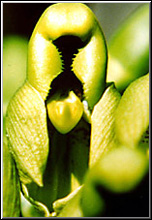 Catasetum purum |
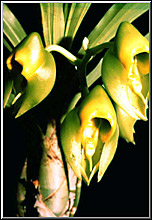 Catasetum macrocarpum |
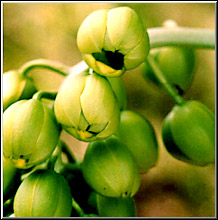 Catasetum luridum |
|
Those environments have not been studied under no point of view and we are just talking about orchids. If we talk about the other trees, how many trees, leguminosae, should occur in Espírito Santo? Nobody knows. Espírito Santo is a big botanical hole, for everything. Nowadays, fortunately, I can extend the research in my doctorate. Today, I send my project for studying the sandbanks of the south of Bahia, Espírito Santo and Rio de Janeiro, comparing them with the forests of the interior. I will study those forests such as Itacaré, Una, Linhares Environmental Reserve, Santa Lúcia, in Santa Teresa and here in Rio de Janeiro, I will study Macaé de Cima which is already published and also many other studies about the internal woods. I want to compare the sandbanks' flora with the flora of those internal areas in order to know if the plants are distributed from the north to the south or into or towards the continent. According to a result I got, it seems to be towards the continent, I want to prove it. How could I do something like that, if I didn't have Espírito Santo already surveyed? In Rio de Janeiro, it is different; there is a lot of material placed in herbariums. ON: Into or towards the continent, you mean. Cláudio:
Let' start with the coast. The sandbank is situated in the border of the
beaches and has been formed by the dynamic sea action. The sea raised
in a certain geological age, which was not the Tertiary age but the Quartenary,
already human age, the man was already in earth, the sea had transgressed
its coastal line, got into the continent, ascended some meters and spread
over the plan areas, mainly where the Tableland forests are, in the north.
Why? Because the terrain is more flat, the sea could advance more. After,
this sea moved back and the sand stayed there. Who colonized this sand?
That is the great question. Some species colonized and after that? Those
species distributed themselves all long the coast or they go on having
their distribution clutched at the internal forest or older regions? It
seems that it is no useful to compare the sandbank in Rio Grande do Sul
with that in Santo because they will be different, because they have to
be different. ON: Of course, another formation... Cláudio: There are some things that get our attention. In the sandbank, for example, there are bushes that also exist in the states of Paraná, São Paulo, Rio de Janeiro, Espírito Santo, but the species occurring inside them are different. The point is to find out what keeps that formation, that shape or could the species be substituted and the shape remains the same? How does this process work? So my study about orchids will be pioneer and will be the base for other studies in the same direction and, in the future, when someone does phytogeographical studies, the ecosystem can be understood. The species are substituted, the distribution is interrupted, or to put another way, the species start here and finish there. However those species that succeed each other are closely related or not? This substitution doesn't interfere in the shape because the bush will be always identical, if you get in, it is completely different. In Espírito Santo, there is a Myrtaceae called Neomitranthes obtusa which it the main phorofyte (where the orchids settle down) and the orchids stay there as epiphyte. In Rio de Janeiro, the plant doesn't exist, I don't know yet very well the sandbanks here but, another plant substitutes that one.
Cláudio: I see that many things which are only reported to Minas also occurring in Espírito Santo. ON: It will be the same to Bahia. Cláudio: Yes. When you say that a plant doesn't respect the official frontier, I know that, however the investments do. A financial support to survey the flora such exists in São Paulo and is about to be done in Rio de Janeiro respects the official frontier. Those states have the power of money, the power of fighting for having more money. Espírito Santo is land of no one, is the poor state of the southeast, so it will remain behind in the study of its flora. ON: Why, in the past, during the period of the great travels, it was not so studied as Minas, for example? Cláudio: Well, many times, the great travels just passed one time in each place. In Minas Gerais, many people stayed there because of the gold. On: It was a rich state by this time. Cláudio: If you look the map of Espírito Santo, sixty years ago, beyond the Doce River was considered as unknown swamp, forest good for railways sleepers, Indian territory and so on. This unknown swamp is part of the sandbank I have studied. 60 years ago, Espírito Santo was in the same situation in the Brazilian map. ON: Sixty years ago is too recent. Cláudio: Yes, it is. For example, in Minas Gerais, many people lived there because there was a movement. The Espírito Santo não didn't have it. The state grown with the coffee, but we have never seen it planted in the tableland, in the sandbanks neither in the internal part of the Atlantic Forest, unless when irrigated. There is no irrigation by this time. Where did the coffee go? Santa Teresa, Santa Leopoldina, Domingos Martins, Vila Nova do Imigrante. I am talking about the side facing the sea, where people passed. It is a narrow strip. Many botanists stayed in Brazil, Regnel stayed longtime in Minas Gerais, he came from the Sweden and settled down there. Why? Because there were many companies involved specially with mining industries. Looking for ore was a success, so ... ON: Due to the opulence... CL: The opulence or the nobility. Rio de Janeiro was the capital city of Brazil, the king, Dom João VI, decided to create the Botanical Garden with a herbarium and the National Museum with another herbarium. In this city, many people who were born here or adopted here, loved to discover what was a herbarium. Pabst created his own and finishing for having 80.000 as if you start, at home, to place exsiccates in the wardrobe. Nowadays it is the Herbário Bradeanum. ON: It is very important to know this Herbarium. It has been the subjected of Orchid News # 11. And who did also study Espírito Santo? Cláudio: Augusto Ruschi who effectively started in l950. ON: Who became, popularly, known by his studies about the hummingbirds. Cláudio:
Hummingbird in Santa Teresa stays in your finger, you can give water to
drink in a small bottle. If Augusto Ruschi wanted to study hummingbird or
if the hummingbird hit him, I don't know but what a fantastic place, Santa
Teresa, indeed... ON: A high incidence by m²... Cláudio: It is very clear it. Augusto Ruschi, in his first day, collected from the number 1 until 50 and so. In Santa Teresa, when I went to work in Mello Leitão Museum, in my first day of work, I collected 63 blooming plants while in the sandbanks, during 3 years, I just found 73 plants. Imagine, in my first day, collecting 63 blooming plants without repetition! I don't know how many plants Ruschi collected because besides orchids, he collected another families. He sent plants to Hoehne, the botanist who created the Botanical Institute of São Paulo. He described 2 species: Campylocentrum crassirhizum and Pleurothallis ruschii. They are very different and are valid. I have never seen Pleurothallis ruschii in anywhere else. I am describing Myoxanthus ruschii we found in another environmental reserve in Santa Teresa, but it is on the top, not in the hillside. Or Santa Teresa is a privileged place or it is a place that has a scientific institution that can bring biologists who can collect plants. I think the same should occur in Domingos Martins, in Santa Leopoldina, in backside of the mountain, Itarana, Itaguaçu, there are many areas which are little studied. I will use Santa Lúcia in my doctorate's thesis. |
|
|
(*) Localization of studied areas. In
function of the characteristics of the geomorphological units and in function
of the bigger or smaller development of the Quaternary deposits, Martin
et al. (1997) delimitate Espírito Santo's shore in five sectors.
|
| In the sector three, the development of the Quaternary deposits is weakly again, with the foothill of the cliffs getting very close to the sea, extending from Barra do Riacho until Tubarão (Entrance of Vitoria's Bay). All those sectors of Quaternary coastal plains present, in common, the fact of being delimited to the interior by the Tertiary plateau of "Formação Barreiras", forming the north coast of the state of Espírito Santo (image A). The sector four concerns the outcrops of Pre-Cambian crystalline rocks that meet the Quaternary deposits, characterized by presenting a very jagged coast, with well developed deposits in the concave parts and lacking in the prominent parts, forming beaches in small bay with a stone in each side. It goes from the entrance of Vitória's bay until the end of Itapemirim, forming the central coast of Espírito Santo (image B). |
|
| The
sector five extends from the Itapemirim River mouth (the limit between the
districts of Itapemirim in the north and Marataízes in the south),
until the boundary with the state of Rio de Janeiro. This sector is characterized
by a weakly development due to the formation of cliffs in the line of the
beach, in Marataízes. Presenting considerable extensions in the engraved
valleys in the Formação Barreiras, in Presidente Kennedy,
near to Itabapoana River mouth, forming the south coast of the state of
Espírito SantoThe sector five extends from the Itapemirim River mouth
(the limit between the districts of Itapemirim in the north and Marataízes
in the south), until the boundary with the state of Rio de Janeiro. This
sector is characterized by a weakly development due to the formation of
cliffs in the line of the beach, in Marataízes. Presenting considerable
extensions in the engraved valleys in the Formação Barreiras,
in Presidente Kennedy, near to Itabapoana River mouth, forming the south
coast of the state of Espírito Santo (image
C). (*) Extract from the pos-graduation thesis (editor's note) |
ECOLOGY, PHYTOGEOGRAPHY, CONSERVATION |
|
ON: In your thesis, you approached the ecology, phytogeography and conservation of the orchids from the sandbanks of the state of Espírito Santo. Why did you choose those themes and how did you approach them? Cláudio: I will explain why I decided to do it in this way. I had got married recently and used to live in Vitória, so I came o Rio de Janeiro because it is close to my home. Here I went the National Museum to get my second university degree in Botany and inside this subject, I could choose any direction. I could have studied a group but I should examine type-materials, a great number of exsiccates and the time was short andI did not have anyone to orientate the revision of a section or a genus, even a small genus such as Notylia, for example. So I decided to get into the floristics. I have already started this project with the orchids from sandbanks in Espírito Santo and it could be finished during the elaboration of my thesis. That is why I decided to study the presence and the lack of the orchids and where they occur inside the sandbanks of Espírito Santo. Many aspects of the orchids in sandbanks represent the word ecology in this title. |
| The
phytogeography attracted me because I realized that in Espírito Santo,
there was a phytogeographic barrier: Rio Doce (Doce river) or those tertiary
woods, those forests of tableland (or plateau). I noticed that the sandbank situated in the north was very different from that in the south. The analysis of the distribution of the orchids showed a group of plants which occur exclusively in the north and another one exclusively to the south sandbank. Every time you identify a plant, you try to get more information about it, where it comes from, where it occurs. I noticed that many plants found in the sandbanks of Espírito Santo occur in Amazon such as Galeottia ciliata. That was an odd thing. What this plant is doing here? I also noticed that they also occur in tableland forest. It is known that the tableland forest has a strong connection with the Amazon region. This kind of thing make me curious and pushed me to study phytogeography. I wouldn´t do the study about conservation, I did it due to the funds I got from "O Boticário" to study the conservation. |
|
| I realized that I could take a report with information about it and include in my thesis. I decide to include it during the last week before to submit my thesis. This is to me, perhaps, the most terrific study in the thesis. |
| Then
there was the money from WWF also conditioned to conservation. So, I included
conservation to get funds but today I see it in another way: The conservation
motives everything. You should study having in view the utility. Staying
in the office doing taxonomy, studying group or phitogeography, would bring
you to nothing. I present the status of conservation of each species and give the information having in view the conservation of species and habitats. At the end of the thesis, I inferred areas to become an unity of conservation concerning, for example, Laelia grandis or Sophronitis grandis. Why? Because it is a plant, which is in the south of Bahia and in the north of Espírito Santo and nowhere also. I found this plant in a sandbank area not yet very devastated which is not a unity of conservation. I though that it was worth to separate this area as an unity of conservation. If it will be done or not, I don't know, I should present my self as candidate to a position in a civil service to accomplish certain things. |
|
| However, I think that, as contribution, the chapter conservation represented something beyond the scientific. So, those are, really, the three great objects approached in my thesis. |